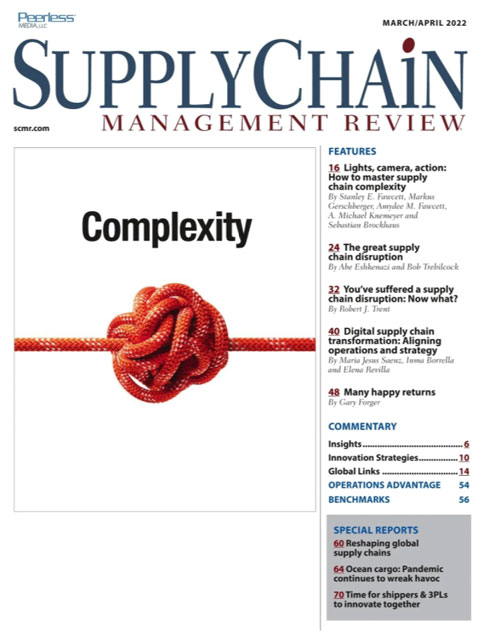Sorry, but your login has failed. Please recheck your login information and resubmit. If your subscription has expired, renew here.
March-April 2022
Yesterday, I hosted a webinar on the steps supply chain leaders are taking to redesign their supply chains to cope with this period of unprecedented demand. Earlier last month, I attended the Manifest conference in Las Vegas. The exhibitors featured a lineup of supply chain startups while the attendee list was dominated by venture capital firms looking to get in on the action in our booming industry. This morning, one of the lead news stories is about another disruption threatening to bring global supply chains to a halt: Browse this issue archive.Need Help? Contact customer service 847-559-7581 More options
The supply chain is no longer perceived as a cost center. Now, it’s considered a critical component of a company’s business strategy, and digitalization is reinforcing supply chain’s importance as a strategic resource. Digital technologies enable the supply chain—and hence the company—to meet the needs of increasingly demanding digital customers. And these technologies are transforming relationships within enterprises and externally with partners by increasing transparency and collaboration across the end-to-end supply chain.
These changes are yielding new business opportunities including enhanced productivity, deeper links with customers, mass customization and cost reduction. Studies show that digital supply chain transformation, or DSCT, can improve customer service by 30% and reduce costs by up to 20%. However, even companies that give DSCT a high priority face major hurdles to realizing this goal.
According to the research firm Gartner, “the transformation journey is taking large enterprises at least twice as long and costing twice as much as they originally anticipated.” Many companies seem dissatisfied with the pace and impact of their digital transformations, as mounting investments are stubbornly slow to yield breakthroughs in supply chain performance. As was noted in an article by Paul Leinwand and Mahadeva Matt Mani in the Harvard Business Review, many executives express concerns that they are falling behind on making the important choices that lead to supply chain differentiation.
Recent studies, such as one from supplychaindigital.com, show that while 70% of companies say they have started a formal DSCT effort, less than half have defined or plan to implement a supply chain digital transformation roadmap. And most importantly, more than 30% are “dissatisfied” with their progress so far.
In this article, we describe some of the main reasons why companies are experiencing a mismatch between expectations and reality in their DCST efforts. And we present a supply chain-based framework that helps companies new to DSCT, or that are struggling with its complexity and magnitude, to avoid these common pitfalls. The framework is derived from research work we carried out in this area with more than 40 companies, some of them leaders in their segments. Additionally, we show how the framework has been successfully deployed as part of the DSCT strategies of two leading companies, Dell and Coca-Cola Femsa.

This complete article is available to subscribers only.
Log in now for full access or start your PLUS+ subscription for instant access.
SC
MR
Sorry, but your login has failed. Please recheck your login information and resubmit. If your subscription has expired, renew here.
March-April 2022
Yesterday, I hosted a webinar on the steps supply chain leaders are taking to redesign their supply chains to cope with this period of unprecedented demand. Earlier last month, I attended the Manifest conference in… Browse this issue archive. Access your online digital edition. Download a PDF file of the March-April 2022 issue.The supply chain is no longer perceived as a cost center. Now, it’s considered a critical component of a company’s business strategy, and digitalization is reinforcing supply chain’s importance as a strategic resource. Digital technologies enable the supply chain—and hence the company—to meet the needs of increasingly demanding digital customers. And these technologies are transforming relationships within enterprises and externally with partners by increasing transparency and collaboration across the end-to-end supply chain.
These changes are yielding new business opportunities including enhanced productivity, deeper links with customers, mass customization and cost reduction. Studies show that digital supply chain transformation, or DSCT, can improve customer service by 30% and reduce costs by up to 20%. However, even companies that give DSCT a high priority face major hurdles to realizing this goal.
According to the research firm Gartner, “the transformation journey is taking large enterprises at least twice as long and costing twice as much as they originally anticipated.” Many companies seem dissatisfied with the pace and impact of their digital transformations, as mounting investments are stubbornly slow to yield breakthroughs in supply chain performance. As was noted in an article by Paul Leinwand and Mahadeva Matt Mani in the Harvard Business Review, many executives express concerns that they are falling behind on making the important choices that lead to supply chain differentiation.
Recent studies, such as one from supplychaindigital.com, show that while 70% of companies say they have started a formal DSCT effort, less than half have defined or plan to implement a supply chain digital transformation roadmap. And most importantly, more than 30% are “dissatisfied” with their progress so far.
In this article, we describe some of the main reasons why companies are experiencing a mismatch between expectations and reality in their DCST efforts. And we present a supply chain-based framework that helps companies new to DSCT, or that are struggling with its complexity and magnitude, to avoid these common pitfalls. The framework is derived from research work we carried out in this area with more than 40 companies, some of them leaders in their segments. Additionally, we show how the framework has been successfully deployed as part of the DSCT strategies of two leading companies, Dell and Coca-Cola Femsa.
SC
MR


Latest Supply Chain News
- Inflation, economic worries among top supply chain concerns for SMBs
- April Services PMI declines following 15 months of growth, reports ISM
- Attacking stubborn COGS inflation with Digital Design-and-Source-to-Value
- Despite American political environment, global geopolitical risks may be easing
- Joseph Esteves named CEO of SGS Maine Pointe
- More News
Latest Podcast

 Explore
Explore
Software & Technology News
- Technology’s role in mending supply chain fragility after recent disruptions
- Tech investments bring revenue increases, survey finds
- Survey reveals strategies for addressing supply chain, logistics labor shortages
- AI, virtual reality is bringing experiential learning into the modern age
- Humanoid robots’ place in an intralogistics smart robot strategy
- Tips for CIOs to overcome technology talent acquisition troubles
- More Software & Technology
Latest Software & Technology Resources

Subscribe

Supply Chain Management Review delivers the best industry content.

Editors’ Picks






